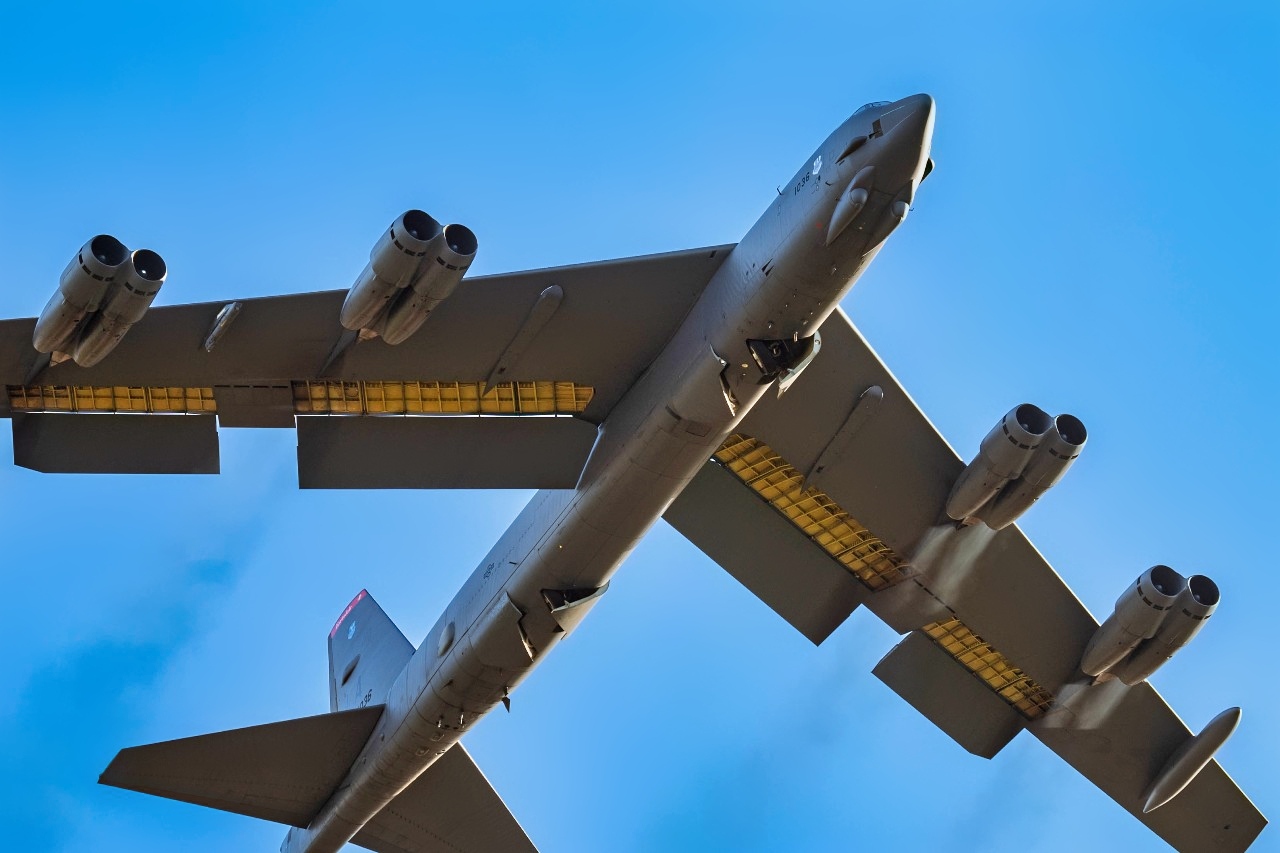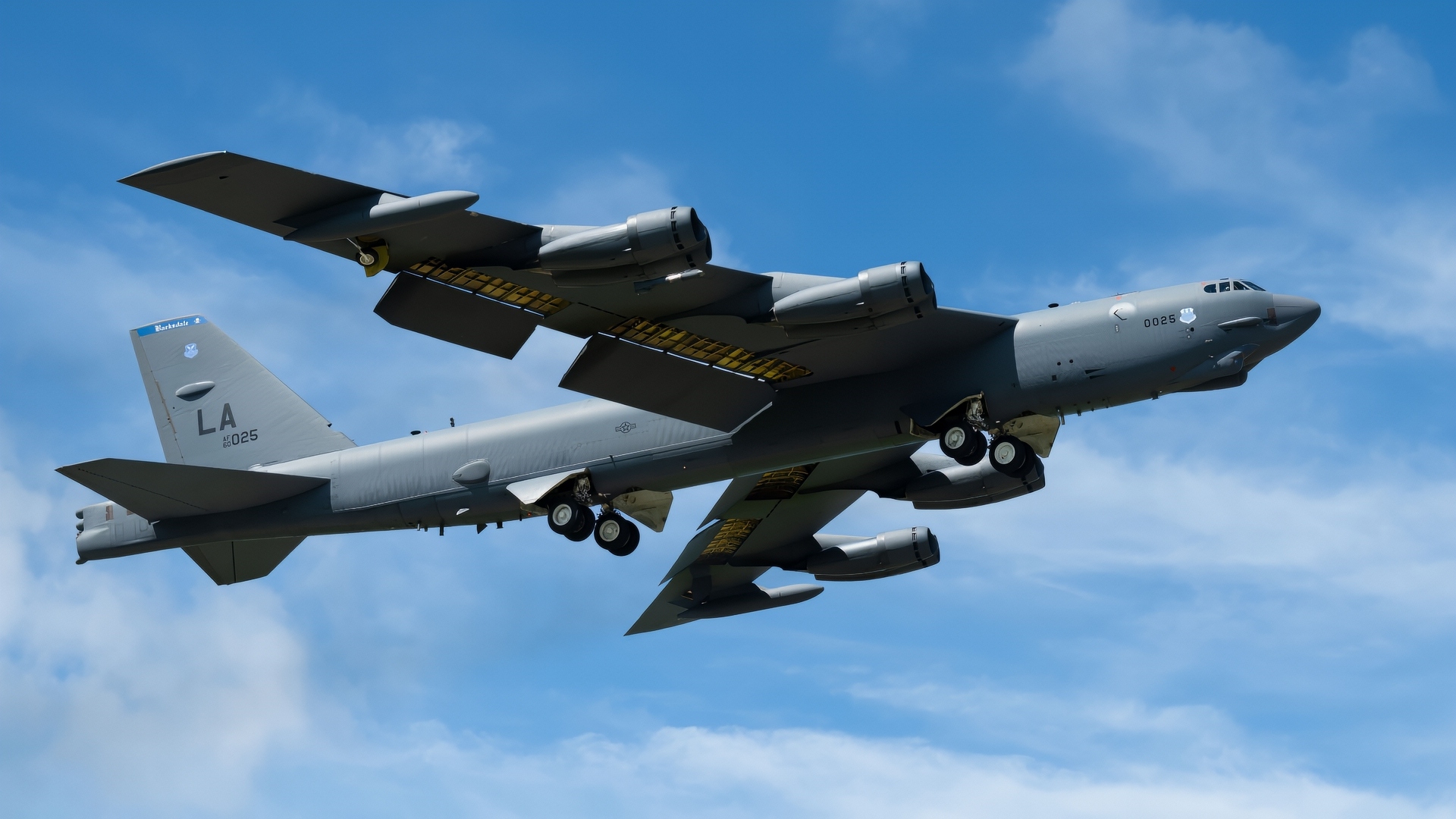Key Points and Summary – Keeping the B-52J flying into its second century isn’t nostalgia, but comes down to one word—it’s math.
-In a decade of too few stealth bombers, uneven fighter readiness, and thin missile stockpiles, a modernized B-52J delivers mass at range: lots of smart weapons, launched reliably, from outside the hottest threat rings.
-New F130 engines boost availability and range, a mission-tuned radar sharpens targeting and weather work, and rewired pylons turn the BUFF into a true weapons truck—conventional or nuclear.
-Yes, it’s late and pricey. But compared to waiting for more B-21s, upgrading an existing fleet buys time, depth, and persistent pressure at a lower cost per effect.
The B-52J Bomber Fills a Critical Need
Keep the B-52 flying into its second century?
On its face, that sounds like sentimentality wrapped in sunk costs. It isn’t. It’s a hard-headed choice about mass at range, how the United States sustains a credible strike capacity in a decade when the Air Force will field too few stealth bombers, with uneven fighter availability, and the need to launch large numbers of long-range weapons without burning out its most exquisite assets.
The logic is simple enough to withstand contact with budgets and delays: a modernized B-52J is the most cost-effective—and fastest—way to achieve the magazine depth and endurance the joint force needs, even if it arrives later and costs more than initially planned.
The Old Stratofortress
First, consider the purpose. The modern Big Ugly Fat Fellow is not a knife-fighter; it is a long-range weapons truck that does not have to cross a hostile radar lobe to matter. In an era of scarce stealth and abundant targets, the air force needs capacity: aircraft that can lift cruise missiles, maritime-strike weapons, and ultimately hypersonic cruise missiles from outside the densest threat rings.
The B-21 provides reach and penetration. The B-52 offers volume and persistence. In light of that division of labor, the B-52J is unglamorous—but strategically essential.
Bringing the BUFF Up to Date
From purpose flows the modernization logic. Think of the upgrade as an industrial-scale refit that turns a durable airframe into a predictable arsenal. In terms of propulsion, the new F130 engines, paired with redesigned inlets, aim to address the airflow variability that threatened reliability and performance.
Solve that, and you unlock the cascade that matters in operations: fewer engine removals, better fuel burn, longer unrefueled legs, and surplus electrical power for today’s electronics. On sensing, the AN/APQ-188 radar is being finalized with a tight focus on modes that make a stand-off arsenal lethal: wide-area maritime search with tracks good enough for weapon hand-off; ground-moving target indication for cueing and assessment; and weather penetration to keep timelines intact when the atmosphere misbehaves.
On carriage, rewired pylons and power provisioning enable meaningful loads—multiple conventional cruise missiles per sortie, robust maritime-strike packages, and a growth path for hypersonic cruise as it matures—while ensuring the nuclear Long-Range Stand-Off weapon integrates cleanly.
Engines keep jets on the line; radar makes each round smarter; pylons turn capacity into delivered effects.
BUFF in the Skies
Only then should we tally the bill and check the clock. Costs rose as the program bought engines at scale; tooled and tested redesigned inlets; upgraded wiring, displays, communications, and pylons across the fleet; and absorbed radar hardware and software rework, including nuclear-hardening and radome changes.
Delays stemmed from engineering and throughput issues: inlet aerodynamics that necessitated redesign and new wind-tunnel testing; environmental qualification and integration challenges on the radar, including tight nose-fit tolerances; and tail-by-tail modifications through finite depot lines. The result is an initial operational capability in the early to mid-2030s, accompanied by a higher overall price tag than initially briefed.
Set those realities against the force America will actually field. The Air Force of the 2030s will have a B-21 fleet measured in dozens, not hundreds. Fighters will continue to wrestle with sustainment cycles and training demands. Munitions inventories will matter only if platforms can throw them in volume. In that world, an engine-modernized, radar-competent, heavy-pylon B-52 is not a luxury add-on. It is the backbone of strike capacity—the airplane that absorbs non-penetrating missions, preserves stealth sorties for what only stealth can do, and turns replenished magazines into persistent pressure.
Against that backdrop, the neat counterproposal—retire early and buy more B-21s and missiles—falls to earth. Even with money, bomber production and crew generation move at a deliberate pace with test, training, and sustainment pipelines that cannot be wished away.
By contrast, re-engining and refitting the B-52 converts an existing, trained force into a more available, more useful one on a schedule the joint force can actually use. That conversion buys what the United States lacks most in a contested decade: time. Time to ramp stealth inventory without flying it to exhaustion. Time to rebuild the missile industrial base. Time to harden and iterate the kill chain already in hand.

A B-52H Stratofortress assigned to the 20th Expeditionary Bomb Squadron takes off from RAF Fairford, England, for a training mission with the Royal Moroccan Air Force during Bomber Task Force 25-1, Nov. 22, 2024. The U.S. and Morocco’s strategic partnership is based on mutual interests in regional peace, security and prosperity, and we remain dedicated to working together on shared concerns. (U.S. Air Force photo by Senior Airman Mary Bowers)

A U.S. Air Force B-52 Stratofortress, assigned to the 5th Bomb Wing, conducts aerial refueling with a KC-135 Stratotanker, assigned the 350th Expeditionary Air Refueling Squadron, June 14, 2024 during a presence patrol mission over the U.S. Central Command area of responsibility. The B-52 is capable of flying at high subsonic speeds, at altitudes of up to 50,000 feet, within the atmospheric tropopause, with worldwide precision navigation capability, providing a unique rapid response to senior coalition leaders globally. (U.S. Air Force photo by Tech Sgt. Ashley Sokolov)
Measured correctly, affordability strengthens the case. Sticker shock is not a strategy; cost per delivered effect is. The relevant question is how many long-range weapons you can launch reliably, month after month, in multiple theaters, without cannibalizing the rest of the force. On that math, the B-52J pays for itself.
The B-52J Variant
Reliable engines raise mission-capable rates. A competent radar raises lethality and reduces re-attacks. Certified pylons raise volume per sortie. Together, they lower the cost of sustained coercive pressure—from maritime interdiction in the Western Pacific, to long-range strikes that complicate enemy air defenses, to quiet deterrence across the Arctic and North Atlantic seams.
Quality at the finish line clinches it. The propulsion fix is a one-time pain that yields decades of steadier performance. The radar suite is aligned with what the mission actually demands rather than festooned with “nice-to-have” features. The pylons and wiring are set for the weapons that matter now and the ones that are arriving next.
This is not nostalgia dressed up as modernization; it is a disciplined rebuild to field a heavy hitter that does exactly what the force needs—launch a lot of smart weapons from far away, predictably.
Execution, not reinvention, will carry it across the line. Keep the design locked. Keep the schedule tight. Tie every upgrade to a mission the force actually needs. That means engines that stay on the wing, radar modes that feed stand-off employment, resilient navigation and communications that ride out a jammed spectrum, and pylons that carry the weapons that matter. Skip boutique features that reopen software and slip the clock. The goal is predictable sorties and full racks, not show-and-tell.

A B-52H Stratofortress assigned to the 419th Flight Test Squadron is undergoes pre-flight procedures at Edwards Air Force Base, California, Aug. 8. The aircraft conducted a captive-carry flight test of the AGM-183A Air-launched Rapid Response Weapon Instrumented Measurement Vehicle 2 at the Point Mugu Sea Range off the Southern California coast. (Air Force photo by Giancarlo Casem)
Viewed end-to-end, the trade-off is worth making. Yes, the B-52J is very costly and very late. No, it is not too costly or too late for the world that the United States actually faces. It delivers needed capacity within an acceptable—if not optimal—window and at a justified price for what it returns: reliable mass at range.
Finish the modernization with focus and discipline, and the weapons truck will do exactly what it is intended to do—fill the gap that must be filled, at an acceptable cost and on a tolerable clock.
The last Stratofortress that rolled off the line in 1962 will still be earning its keep in 2042—not as a museum piece, but as the most dependable way to turn stockpiled range into real deterrence.
About the Author: Dr. Andrew Latham
Andrew Latham is a Senior Washington Fellow with the Institute for Peace and Diplomacy, a non-resident fellow at Defense Priorities, and a professor of international relations and political theory at Macalester College in Saint Paul, MN. You can follow him on X: @aakatham. He writes a daily column for the National Security Journal.
More Military
Su-57 Felon vs. Eurofighter Typhoon: Who Wins?
The P-8A Poseidon Might Be the Ultimate Submarine Hunter
The S-3 Viking: The Best Submarine Killer Retired?











Jim
October 1, 2025 at 1:47 pm
We need airframes and the B-52 is serviable as a stand-off weapons platform.
We need numbers. We can’t afford to cut our numbers for a few bright shiny aircraft.
We need to conserve our numbers not retire them.
The B-21 Raider won’t have the numbers for a while… and given procurement practices & speed, it’ll be a while still.
Meanwhile…
Keep the B-52 flying, bang for the buck, it’s a good deal, and with the necessary modernization, the platform can still deliver the goods where we need them and when we need them.
That’s all good in my book.
Martin L Schneider
October 10, 2025 at 5:58 pm
The reason it takes so long to do anything is that we have came to believe it is acceptable and normal. Make that unexceptable and believe the problem can be fixed and things will change. A good example is Albert Speer, architect by training, who was put in charge of armament manufacture in Nazi Germany. He tripled manufacturing in two years. When ask how he did it he replied “I didn’t know it was impossible”